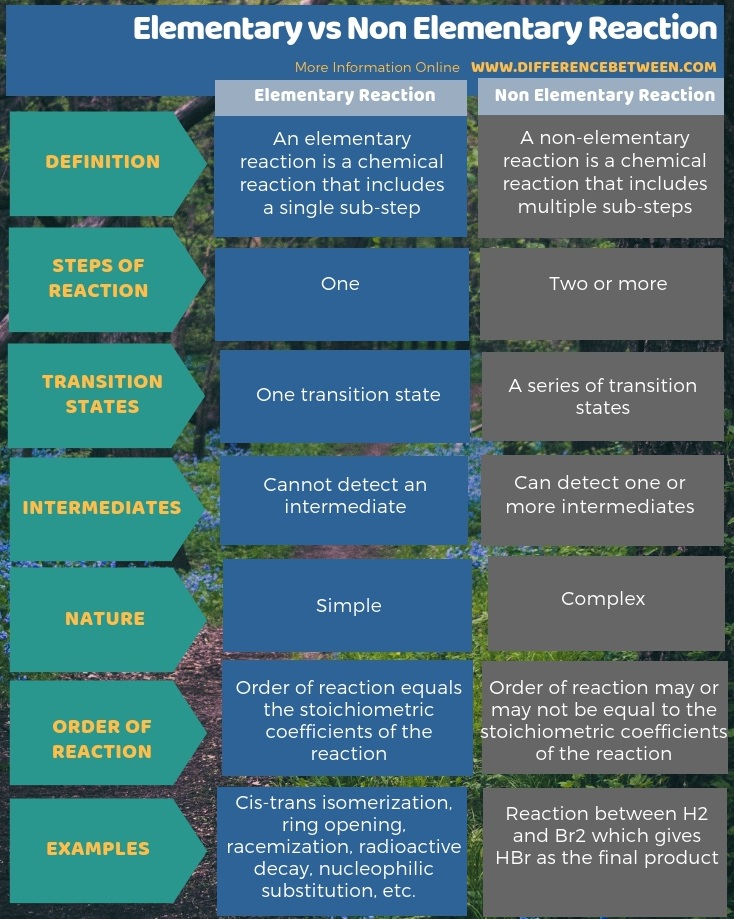Difference Between Elementary and Non Elementary Reaction
Table of Contents
The key difference between elementary and non elementary reaction is that the elementary reactions have a single step, while the non-elementary reactions have multiple steps.
We can classify chemical reactions in different ways depending on different factors, such as reactants of the reaction, product of the reaction, catalysts, order of the reaction, rate of the reaction, etc. Of these, the elementary and non-elementary reactions are divided based on the number of sub-steps of the chemical reaction.
CONTENTS
1. Overview and Key Difference
2. What is an Elementary Reaction
3. What is a Non Elementary Reaction
4. Side by Side Comparison – Elementary vs Non Elementary Reaction in Tabular Form
5. Summary
What is an Elementary Reaction?
An elementary reaction is a chemical reaction that includes a single sub-step. In these reactions, one chemical species undergoes a direct change to give the final product in one step. Here, a single transition state is observed. Experimentally, if we cannot detect any intermediate products during a chemical reaction, we can categorize that reaction as an elementary reaction.

Figure 01: An Elementary Reaction in Organic Synthesis
Furthermore, there are several types of elementary reactions. They are as follows:
Unimolecular Reactions
In this, a single reactant undergoes a reaction such as a decomposition to give the final product(s). Examples of unimolecular reactions include cis-trans isomerization, ring-opening, racemization, radioactive decay, etc.
Bimolecular Reactions
Meanwhile, in bimolecular reaction, two particles undergo collision to give the product(s). These are second-order reactions because the rate of the reaction depends on both reactants. Examples include nucleophilic substitution reactions.
Trimolecular Reactions
Similarly, in the trimolecular reaction, three particles undergo collision at the same time to give the product(s). However, this type is rare because it is difficult for three reactants to collide at the same time.
What is a Non Elementary Reaction?
A non-elementary reaction is a chemical reaction that includes multiple sub-steps. That means; these reactions have a series of steps and different transition states with different intermediates as well. Therefore, these reactions are very complex in nature.

Figure 02: Graph for a Two-Step Reaction
Furthermore, unlike in elementary reactions, the order of the reaction does not agree with the stoichiometric coefficients of the reaction. Apart from that, the order of these reactions can be either an integer or a fraction.
What is the Difference Between Elementary and Non Elementary Reaction?
The difference between elementary and non elementary reactions depends on the number of sub-steps of the chemical reaction. Hence, the key difference between elementary and non elementary reaction is that elementary reactions have a single step while non-elementary reactions have multiple steps. Therefore, in elementary reactions, there is a single transition state, and there are no detectable intermediates produced during the reaction. However, in non-elementary reactions, there is a series of transition states with multiple intermediates we can detect easily.
Furthermore, elementary reactions are simple, while non-elementary reactions are complex. In an elementary reaction, the order of reaction equals the stoichiometric coefficients of the reaction while, in non-elementary reaction, the order of reaction may or may not be equal to the stoichiometric coefficients of the reaction.
The below infographic shows more details on the difference between elementary and non elementary reaction.

Summary – Elementary vs Non Elementary Reaction
In summary, elementary and non-elementary reactions are divided based on the number of sub-steps of the chemical reaction. Hence, the key difference between elementary and non-elementary reactions is that elementary reactions have a single step, while non-elementary reactions have multiple steps.
Reference:
1. Helmenstine, Anne Marie. “Elementary Reaction Definition.” ThoughtCo, Dec. 6, 2018, Available here.
2. Ddy, Prawin. “Elementary and Non Elementary Reaction(No-18) – Copy.” LinkedIn SlideShare, 29 Oct. 2015, Available here.
Image Courtesy:
1. “Nucleophilic attack of oxonium ion” By Fhenatizs – Own work (CC BY-SA 4.0) via Commons Wikimedia
2. “Oxalic acid titration grid” By MHz`as – Transferred from en.wikipedia (CC BY-SA 3.0) via Commons Wikimedia
ncG1vNJzZmivp6x7pbXFn5yrnZ6YsqOx07CcnqZemLyue8OinZ%2Bdopq7pLGMm5ytr5Wau26xy56knqaklr%2B6ecCnm2amn6N6prjEppynrJGnxm6%2BxJqaraGfo3w%3D